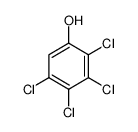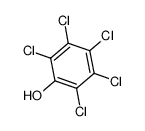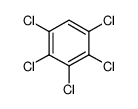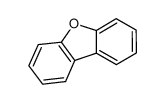1.Identification
1.1 GHS Product identifier
| Product name | 2,3,4,5-TETRACHLOROPHENOL |
|---|
1.2 Other means of identification
| Product number | - |
|---|---|
| Other names | 1,2,3,4-TETRACHLORO-6-HYDROXYBENZENE |
1.3 Recommended use of the chemical and restrictions on use
| Identified uses | For industry use only. |
|---|---|
| Uses advised against | no data available |
1.4 Supplier's details
| Company | MOLBASE (Shanghai) Biotechnology Co., Ltd. |
|---|---|
| Address | Floor 4 & 5, Building 12, No. 1001 North Qinzhou Road, Xuhui District, Shanghai, China |
| Telephone | +86(21)64956998 |
| Fax | +86(21)54365166 |
1.5 Emergency phone number
| Emergency phone number | +86-400-6021-666 |
|---|---|
| Service hours | Monday to Friday, 9am-5pm (Standard time zone: UTC/GMT +8 hours). |
2.Hazard identification
2.1 Classification of the substance or mixture
Acute toxicity - Oral, Category 3
Skin irritation, Category 2
Serious eye damage, Category 1
Specific target organ toxicity – single exposure, Category 3
Hazardous to the aquatic environment, short-term (Acute) - Category Acute 1
Hazardous to the aquatic environment, long-term (Chronic) - Category Chronic 1
2.2 GHS label elements, including precautionary statements
| Pictogram(s) |    |
|---|---|
| Signal word | Danger |
| Hazard statement(s) | H301 Toxic if swallowed H315 Causes skin irritation H318 Causes serious eye damage H335 May cause respiratory irritation H410 Very toxic to aquatic life with long lasting effects |
| Precautionary statement(s) | |
| Prevention | P264 Wash ... thoroughly after handling. P270 Do not eat, drink or smoke when using this product. P280 Wear protective gloves/protective clothing/eye protection/face protection. P261 Avoid breathing dust/fume/gas/mist/vapours/spray. P271 Use only outdoors or in a well-ventilated area. P273 Avoid release to the environment. |
| Response | P301+P310 IF SWALLOWED: Immediately call a POISON CENTER/doctor/… P321 Specific treatment (see ... on this label). P330 Rinse mouth. P302+P352 IF ON SKIN: Wash with plenty of water/... P332+P313 If skin irritation occurs: Get medical advice/attention. P362+P364 Take off contaminated clothing and wash it before reuse. P305+P351+P338 IF IN EYES: Rinse cautiously with water for several minutes. Remove contact lenses, if present and easy to do. Continue rinsing. P310 Immediately call a POISON CENTER/doctor/… P304+P340 IF INHALED: Remove person to fresh air and keep comfortable for breathing. P312 Call a POISON CENTER/doctor/…if you feel unwell. P391 Collect spillage. |
| Storage | P405 Store locked up. P403+P233 Store in a well-ventilated place. Keep container tightly closed. |
| Disposal | P501 Dispose of contents/container to ... |
2.3 Other hazards which do not result in classification
none
3.Composition/information on ingredients
3.1 Substances
| Chemical name | Common names and synonyms | CAS number | EC number | Concentration |
|---|---|---|---|---|
| 2,3,4,5-TETRACHLOROPHENOL | 2,3,4,5-TETRACHLOROPHENOL | 4901-51-3 | none | 100% |
4.First-aid measures
4.1 Description of necessary first-aid measures
General advice
Consult a physician. Show this safety data sheet to the doctor in attendance.
If inhaled
If breathed in, move person into fresh air. If not breathing, give artificial respiration. Consult a physician.
In case of skin contact
Wash off with soap and plenty of water. Consult a physician.
In case of eye contact
Rinse thoroughly with plenty of water for at least 15 minutes and consult a physician.
If swallowed
Never give anything by mouth to an unconscious person. Rinse mouth with water. Consult a physician.
4.2 Most important symptoms/effects, acute and delayed
SYMPTOMS: Symptoms of exposure to this compound may include irritation of the skin, eyes, mucous membranes and upper respiratory tract. Depending on the intensity and duration of exposure, effects may vary from mild irritation to severe destruction of tissue. Prolonged contact can cause eye damage. It can also cause irritation of the nose and throat. Exposure to this type of compound may cause profuse sweating, intense thirst, abdominal pain, nausea, vomiting, diarrhea, cyanosis from methemoglobinemia, hyperactivity, stupor, blood pressure fall, hyperpnea, hemolysis, convulsions, collapse, coma and pulmonary edema followed by pneumonia. If death from respiratory failure is not immediate, jaundice and oliguria or anuria may occur. Other symptoms of exposure to this type of compound may include headache, dizziness, rapid and difficult breathing, weakness, severe burns and internal damage. Chronic exposure may result in digestive disturbances, nervous disorders, skin eruptions and liver and kidney damage. Skin contact with this type of compound may result in softening and whitening of the skin, followed by the development of painful burns. Prolonged contact may lead to dermatitis. Local contact may also result in painless blanching or erythema and corrosion of the skin. Skin sensitivity reactions occur occasionally. ACUTE/CHRONIC HAZARDS: This compound is highly toxic by inhalation, ingestion and skin absorption. It is an irritant of the skin, eyes, mucous membranes and upper respiratory tract; and prolonged contact may result in severe irritation or destruction of tissue. It is also an irritant of the nose and throat. When heated to decomposition it emits toxic fumes of carbon monoxide, carbon dioxide and hydrogen chloride gas.
4.3 Indication of immediate medical attention and special treatment needed, if necessary
Absorption, Distribution and Excretion
The compounds are readily absorbed from the gastroenteric tract and from parenteral sites of injection. /Chlorophenols/
5.Fire-fighting measures
5.1 Extinguishing media
Suitable extinguishing media
Fires involving this material can be controlled with a dry chemical, carbon dioxide or Halon extinguisher.
5.2 Specific hazards arising from the chemical
Flash point data for this chemical are not available. It is probably combustible.
5.3 Special protective actions for fire-fighters
Wear self-contained breathing apparatus for firefighting if necessary.
6.Accidental release measures
6.1 Personal precautions, protective equipment and emergency procedures
Use personal protective equipment. Avoid dust formation. Avoid breathing vapours, mist or gas. Ensure adequate ventilation. Evacuate personnel to safe areas. Avoid breathing dust. For personal protection see section 8.
6.2 Environmental precautions
Prevent further leakage or spillage if safe to do so. Do not let product enter drains. Discharge into the environment must be avoided.
6.3 Methods and materials for containment and cleaning up
Pick up and arrange disposal. Sweep up and shovel. Keep in suitable, closed containers for disposal.
7.Handling and storage
7.1 Precautions for safe handling
Avoid contact with skin and eyes. Avoid formation of dust and aerosols. Avoid exposure - obtain special instructions before use.Provide appropriate exhaust ventilation at places where dust is formed. For precautions see section 2.2.
7.2 Conditions for safe storage, including any incompatibilities
Store in cool place. Keep container tightly closed in a dry and well-ventilated place.
8.Exposure controls/personal protection
8.1 Control parameters
Occupational Exposure limit values
no data available
Biological limit values
no data available
8.2 Appropriate engineering controls
Handle in accordance with good industrial hygiene and safety practice. Wash hands before breaks and at the end of workday.
8.3 Individual protection measures, such as personal protective equipment (PPE)
Eye/face protection
Safety glasses with side-shields conforming to EN166. Use equipment for eye protection tested and approved under appropriate government standards such as NIOSH (US) or EN 166(EU).
Skin protection
Wear impervious clothing. The type of protective equipment must be selected according to the concentration and amount of the dangerous substance at the specific workplace. Handle with gloves. Gloves must be inspected prior to use. Use proper glove removal technique(without touching glove's outer surface) to avoid skin contact with this product. Dispose of contaminated gloves after use in accordance with applicable laws and good laboratory practices. Wash and dry hands. The selected protective gloves have to satisfy the specifications of EU Directive 89/686/EEC and the standard EN 374 derived from it.
Respiratory protection
Wear dust mask when handling large quantities.
Thermal hazards
no data available
9.Physical and chemical properties
| Physical state | PHYSICAL DESCRIPTION: Needles (from petroleum ether, ligroin) or beige solid. |
|---|---|
| Colour | Needles from petroleum ether (sublimes) |
| Odour | no data available |
| Melting point/ freezing point | 69-70ºC |
| Boiling point or initial boiling point and boiling range | 164(3.06kPa) |
| Flammability | no data available |
| Lower and upper explosion limit / flammability limit | no data available |
| Flash point | 4ºC |
| Auto-ignition temperature | no data available |
| Decomposition temperature | no data available |
| pH | no data available |
| Kinematic viscosity | no data available |
| Solubility | less than 1 mg/mL at 21.11°C |
| Partition coefficient n-octanol/water (log value) | log Kow = 4.21 |
| Vapour pressure | no data available |
| Density and/or relative density | 1.6(60/4ºC ) |
| Relative vapour density | no data available |
| Particle characteristics | no data available |
10.Stability and reactivity
10.1 Reactivity
no data available
10.2 Chemical stability
Stable under recommended storage conditions.
10.3 Possibility of hazardous reactions
2,3,4,5-TETRACHLOROPHENOL is incompatible with acid chlorides, acid anhydrides and oxidizing agents .
10.4 Conditions to avoid
no data available
10.5 Incompatible materials
no data available
10.6 Hazardous decomposition products
When heated to decomposition it emits toxic fumes of /hydrogen chloride/.
11.Toxicological information
Acute toxicity
- Oral: LD50 Mouse oral 400 mg/kg
- Inhalation: no data available
- Dermal: no data available
Skin corrosion/irritation
no data available
Serious eye damage/irritation
no data available
Respiratory or skin sensitization
no data available
Germ cell mutagenicity
no data available
Carcinogenicity
no data available
Reproductive toxicity
no data available
STOT-single exposure
no data available
STOT-repeated exposure
no data available
Aspiration hazard
no data available
12.Ecological information
12.1 Toxicity
- Toxicity to fish: LC50 Pimephales promelas (fathead minnow) 410 mg/l/96 hr (confidence limit 380 - 440 mg/l), flow-through bioassay with measured concentrations, 25.7°C, dissolved oxygen 7.5 mg/l, hardness 45.1 mg/l calcium carbonate, alkalinity 41.3 mg/l calcium carbonate, and pH 7.29. Effect: loss of equilibrium
- Toxicity to daphnia and other aquatic invertebrates: no data available
- Toxicity to algae: no data available
- Toxicity to microorganisms: no data available
12.2 Persistence and degradability
31% biodegradation of 2,3,4,5-tetrachlorophenol was reported in an aerobic clay loam soil after 160 days(1). No significant degradation of 2,3,4,5-tetrachlorophenol was reported in an 80 day period in an anaerobic clay loam soil(1). In a river die-away study, 2,3,4,5-tetrachlorophenol had a biodegradation rate constant of 1.4X10-7 M/hr; a lag phase of 400 hours was reported(2). Groundwater containing 2,3,4,5-tetrachlorophenol at an average concn of 140 ug/l was present at 0.04 ug/l in the effluent of a sewage (activated sludge with phosphorus precipitation) treatment plant; dewatered sludge contained this compound at 0.07 mg/kg total solids(3). Half-lives of 2,3,4,5-tetrachlorophenol were reported as 7 (lag phase of 2 days) and 21 (lag phase of 12.5 days) days under aerobic and anaerobic conditions, respectively(4). A first-order biodegradation rate constant of 0.107/day (half-life of 6.5 days) was reported for 2,3,4,5-tetrachlorophenol in anaerobic estuarine sediment(5). Intermediates formed during this reaction are as follows: 3,4,5-trichlorophenol (27%), 2,4,5-trichlorophenol (22%), 2,3,5-trichlorophenol (3%), and 2,3,4-trichlorophenol (5%); 3,4-dichlorophenol>3,5-dichlorophenol>2,4/2,5-dichlorophenol; 3/4-chlorophenol(5). 94.9, 96.5, and 64.9% removal efficiency was reported for 2,3,4,5-tetrachlorophenol initially present at 0.37, 1.20, and 2.21 umol/l, respectively, following treatment in an upflow anaerobic sludge blanket reactor(6).
12.3 Bioaccumulative potential
An estimated BCF of 930 was calculated for 2,3,4,5-tetrachlorophenol(SRC), using a log Kow value of 4.21(1) and a regression-derived equation(2). According to a classification scheme(3), this BCF suggests the potential for bioconcentration in aquatic organisms is high(SRC). BCF values of 38 to 41 and 213 to 351 were measured in two species of earthworms, E. fetida andrei and L. rubellus, respectively(4). Leeches exposed to water in Thunder Bay Harbor, Lake Superior, Canada for 3 weeks bioaccumulated 2,3,4,5-tetrachlorophenol at 63 to 427 ng/g near wastewater discharge points from a pulp mill; at sites located at a greater distance from the discharge area no bioaccumulation in leeches was seen(5).
12.4 Mobility in soil
The Koc of 2,3,4,5-tetrachlorophenol is estimated as approximately 4600(SRC), using a log Kow value of 4.21(1) and a regression-derived equation(2,SRC). According to a classification scheme(3), this estimated Koc value suggests that 2,3,4,5-tetrachlorophenol is expected to have slight mobility in soil(SRC). Koc values of 13200, 13900, and 12500 were measured for a lake sediment (foc=0.094), river sediment (foc=0.026), and aquifer material (foc=0.0084), respectively(7). A Kp value of 0.94 was measured for 2,3,4,5-tetrachlorophenol in aquifer sand at a pH value of 2(4). 2,3,4,5-Tetrachlorophenol added to Eustis fine sand (0.23-0.39% organic carbon; 96.4% sand) had a measured Kp value of 4.19 mL/g; 47% of this compound was ionized in this experiment(6). In addition, a desorption rate coefficient of 2.07 per hour was measured(6). In an aqueous adsorption study, 1360 pg/g 2,3,4,5-tetrachlorophenol was found in the sediment, 480 pg/g in suspended matter, and 2 pg/g in the water; the sediment to water ratio is 680 and suspended matter to water ratio is 240(5).
12.5 Other adverse effects
no data available
13.Disposal considerations
13.1 Disposal methods
Product
The material can be disposed of by removal to a licensed chemical destruction plant or by controlled incineration with flue gas scrubbing. Do not contaminate water, foodstuffs, feed or seed by storage or disposal. Do not discharge to sewer systems.
Contaminated packaging
Containers can be triply rinsed (or equivalent) and offered for recycling or reconditioning. Alternatively, the packaging can be punctured to make it unusable for other purposes and then be disposed of in a sanitary landfill. Controlled incineration with flue gas scrubbing is possible for combustible packaging materials.
14.Transport information
14.1 UN Number
| ADR/RID: UN1230 | IMDG: UN1230 | IATA: UN1230 |
14.2 UN Proper Shipping Name
| ADR/RID: METHANOL |
| IMDG: METHANOL |
| IATA: METHANOL |
14.3 Transport hazard class(es)
| ADR/RID: 3 | IMDG: 3 | IATA: 3 |
14.4 Packing group, if applicable
| ADR/RID: II | IMDG: II | IATA: II |
14.5 Environmental hazards
| ADR/RID: yes | IMDG: yes | IATA: yes |
14.6 Special precautions for user
no data available
14.7 Transport in bulk according to Annex II of MARPOL 73/78 and the IBC Code
no data available
15.Regulatory information
15.1 Safety, health and environmental regulations specific for the product in question
| Chemical name | Common names and synonyms | CAS number | EC number |
|---|---|---|---|
| 2,3,4,5-TETRACHLOROPHENOL | 2,3,4,5-TETRACHLOROPHENOL | 4901-51-3 | none |
| European Inventory of Existing Commercial Chemical Substances (EINECS) | Listed. | ||
| EC Inventory | Listed. | ||
| United States Toxic Substances Control Act (TSCA) Inventory | Not Listed. | ||
| China Catalog of Hazardous chemicals 2015 | Not Listed. | ||
| New Zealand Inventory of Chemicals (NZIoC) | Not Listed. | ||
| Philippines Inventory of Chemicals and Chemical Substances (PICCS) | Not Listed. | ||
| Vietnam National Chemical Inventory | Not Listed. | ||
| Chinese Chemical Inventory of Existing Chemical Substances (China IECSC) | Not Listed. | ||
16.Other information
Information on revision
| Creation Date | Aug 17, 2017 |
|---|---|
| Revision Date | Aug 17, 2017 |
Abbreviations and acronyms
- CAS: Chemical Abstracts Service
- ADR: European Agreement concerning the International Carriage of Dangerous Goods by Road
- RID: Regulation concerning the International Carriage of Dangerous Goods by Rail
- IMDG: International Maritime Dangerous Goods
- IATA: International Air Transportation Association
- TWA: Time Weighted Average
- STEL: Short term exposure limit
- LC50: Lethal Concentration 50%
- LD50: Lethal Dose 50%
- EC50: Effective Concentration 50%
References
- IPCS - The International Chemical Safety Cards (ICSC), website: http://www.ilo.org/dyn/icsc/showcard.home
- HSDB - Hazardous Substances Data Bank, website: https://toxnet.nlm.nih.gov/newtoxnet/hsdb.htm
- IARC - International Agency for Research on Cancer, website: http://www.iarc.fr/
- eChemPortal - The Global Portal to Information on Chemical Substances by OECD, website: http://www.echemportal.org/echemportal/index?pageID=0&request_locale=en
- CAMEO Chemicals, website: http://cameochemicals.noaa.gov/search/simple
- ChemIDplus, website: http://chem.sis.nlm.nih.gov/chemidplus/chemidlite.jsp
- ERG - Emergency Response Guidebook by U.S. Department of Transportation, website: http://www.phmsa.dot.gov/hazmat/library/erg
- Germany GESTIS-database on hazard substance, website: http://www.dguv.de/ifa/gestis/gestis-stoffdatenbank/index-2.jsp
- ECHA - European Chemicals Agency, website: https://echa.europa.eu/














